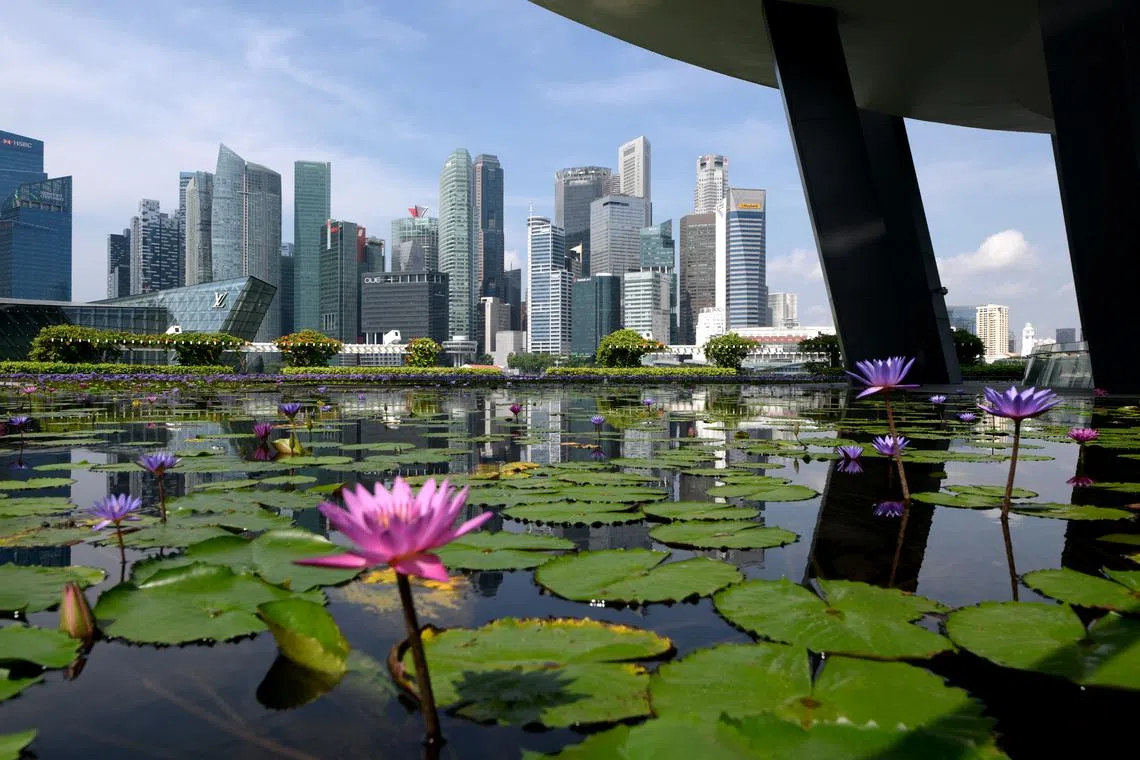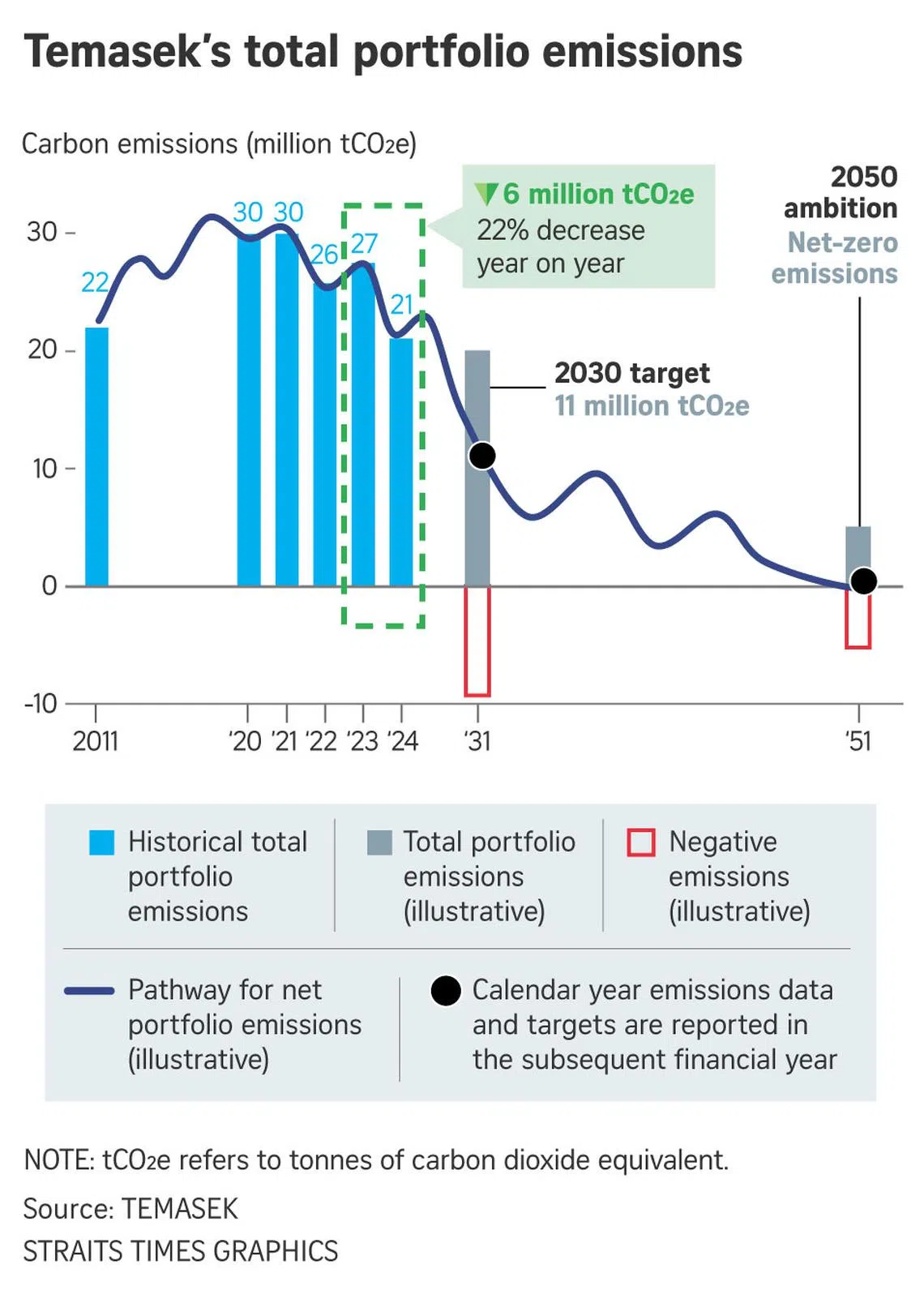Temasek’s portfolio emissions drop 22%; company to step up sustainable investments
Sign up now: Get ST's newsletters delivered to your inbox

Temasek has been investing more in sustainable living by taking stakes in firms with environmental and social objectives, and those that will benefit from sustainability opportunities.
PHOTO: ST FILE
Follow topic:
SINGAPORE – Generating long-term returns while cutting its carbon emissions – those are priorities for Temasek as its strategy of embedding sustainability considerations in its investment decisions continues to pay dividends.
Singapore’s investment company cut its portfolio emissions by 22 per cent for the financial year (FY) ended March 31, while its portfolio value of investments aligned with sustainability stood at $44 billion for the period, it said in its first sustainability report released on July 9.
In FY2024, sustainability-aligned investments accounted for 12 per cent of the investor’s net portfolio value of $389 billion.
Emissions fell to 21 million tCO2e, which refers to tonnes of carbon dioxide equivalent, a standard unit of measurement used in greenhouse gas emissions accounting. Temasek’s aim is to cut emissions to 11 million tCO2e by 2030 and reach net-zero emissions by 2050.
Temasek’s head of real estate Alpin Mehta said: “Sustainability is at the core of everything we do – from our mandate to deliver sustainable returns over the long term, to our strategy of how we operate as an institution, shape our portfolio and engage our portfolio companies to build sustainable businesses.”
The overall decrease in emissions in FY2024 is mainly attributed to Sembcorp Industries, which sold its India energy unit that operates two coal-fired power plants.
“In addition, we are also seeing emissions reductions due to the decarbonisation efforts of our portfolio companies, as well as changes in portfolio composition,” Temasek said.
However, it added that the drop was moderated by an increase in emissions attributable to Singapore Airlines as global air travel continued to resume post-pandemic.
When compared with 2020 levels, Temasek’s portfolio emissions fell 30 per cent.
However, the drop was only 5 per cent when compared against 2010 levels.
Temasek said in the report: “As we continue stepping up efforts to encourage decarbonisation across our portfolio and to invest in less carbon-intensive businesses, we expect a non-linear decline in portfolio emissions over time.”
It added that as an asset owner, achieving its net-zero target by 2050 depends on its portfolio companies hitting their decarbonisation outcomes.
This is why engaging portfolio companies on their climate transition plans is one of Temasek’s key strategies. In the last financial year, it engaged 16 portfolio companies based here and three based overseas.

The top five emissions contributors in Temasek’s portfolio are currently Singapore Airlines, Sembcorp Industries, Olam Group, PSA International and ST Telemedia, which together contributed about 80 per cent of its total portfolio emissions.
Singapore Airlines is currently working on plans to deploy sustainable aviation fuel, which has the potential to reduce carbon emissions by up to 80 per cent on a life-cycle basis, compared with conventional jet fuel.
Sembcorp Industries is also transitioning to a greener asset portfolio by investing in assets that support the energy transition and sustainable urban development.
With climate risks rising, Temasek has also been investing more in sustainable living by taking stakes in companies that have environmental and social objectives, and those that will benefit from sustainability opportunities.
Going forward, Temasek’s key investment focus will be on sustainable living, as well as digitisation, the future of consumption and longer lifespans.
Chief investment officer Rohit Sipahimalani said: “Our exposure to the sustainable living trend is steadily growing as we see more innovation and significant opportunities in this space.
“There is no doubt that if we don’t invest in businesses that are aligned with sustainability principles, it is going to be very difficult to sustain returns because there are no long-term trade-offs between the two.”
Some examples of Temasek’s investments in sustainable living are Ascend Elements, an advanced battery materials producer and recycler, green steel manufacturer H2 Green Steel and eFishery, an aquaculture technology solutions for smallholder farmers.
Said Temasek’s managing director for sustainability Park Kyung-ah: “The transition to a sustainable economy presents both significant opportunities and risks. And a sustainability strategy is about capturing the opportunities and managing the risks, to build a resilient and forward-looking portfolio that really delivers sustainable returns over the long term.”
She added that for all new investments, Temasek conducts due diligence on environmental, social and governance fronts, which include climate change and transition risks.
It uses metrics such as internal carbon pricing, while also looking at risks such as whether the company will be affected by policy changes in the future and if it has a concrete transition plan.
Where companies have physical assets, such as real estate firms, Temasek will look at whether the assets are exposed to risks using a heatmap, to see if properties might be damaged by floods, drought or fires in the future, for instance.
Ms Park noted that Temasek seeks to invest and engage with companies, and help them forge a good transition pathway.
But in some cases where the companies might not be moving fast or if their plans have shifted, Temasek could exit those investments for commercial reasons as the risk is too high.
Ultimately, investing in sustainability is also investing for the future, Ms Park said.
“We have significant conviction that when you actually focus on and invest in sustainable companies... these are the long-term resilient companies that certainly, from a risk perspective, will do better, and also capture the opportunities,” she said.


